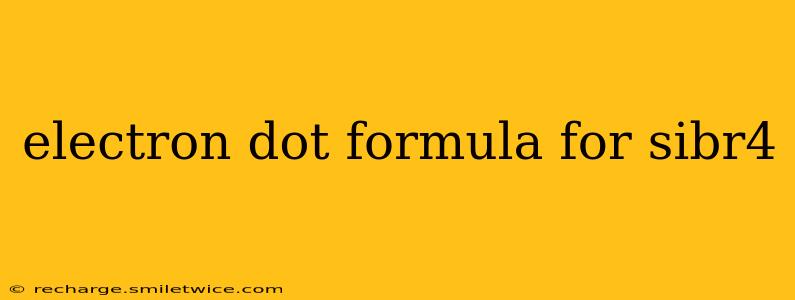Understanding the Electron Dot Formula for SiBr₄ (Silicon Tetrabromide)
Silicon tetrabromide (SiBr₄) is a covalent compound, meaning it's formed by the sharing of electrons between silicon and bromine atoms. To understand its electron dot formula, also known as a Lewis structure, we need to consider the valence electrons of each atom.
1. Valence Electrons:
- Silicon (Si): Silicon is in Group 14 of the periodic table, meaning it has 4 valence electrons.
- Bromine (Br): Bromine is in Group 17, possessing 7 valence electrons.
2. Determining the Central Atom:
Silicon is less electronegative than bromine, making it the central atom in the molecule.
3. Drawing the Electron Dot Formula:
- Place the central atom (Si) in the center.
- Arrange the bromine atoms (Br) around the silicon atom.
- Represent valence electrons as dots around each atom. Silicon starts with four dots, and each bromine atom starts with seven dots.
- Form covalent bonds by sharing electrons between the silicon and each bromine atom. Each bond consists of two shared electrons, represented by a line or a pair of dots between the atoms. Since silicon needs four more electrons to achieve a stable octet, and each bromine needs one more electron, four single bonds are formed between the silicon and each bromine atom.
The final electron dot formula for SiBr₄ looks like this:
..
:Br:
:Br:Si:Br:
:Br:
..
Each bromine atom now has a complete octet (eight valence electrons), and the silicon atom also has an octet.
4. Formal Charges:
All atoms in this structure have a formal charge of zero, indicating a stable and likely arrangement. The formal charge is calculated by: (Valence electrons) - (Non-bonding electrons) - (1/2 Bonding electrons).
5. Molecular Geometry:
The electron dot formula shows a tetrahedral molecular geometry, with bond angles of approximately 109.5°. This is because the silicon atom is surrounded by four bonding pairs of electrons, resulting in a symmetrical arrangement that minimizes electron repulsion.
Frequently Asked Questions (Often found in "People Also Ask" sections):
Q: What is the difference between a Lewis structure and an electron dot formula?
A: The terms "Lewis structure" and "electron dot formula" are often used interchangeably. They both represent the valence electrons and bonding within a molecule. However, sometimes Lewis structures may use lines to represent covalent bonds instead of just dots.
Q: How many lone pairs are there in SiBr₄?
A: There are 24 non-bonding electrons (lone pairs) in SiBr4. Each bromine atom has three lone pairs for a total of 12. The silicon has no lone pairs.
Q: Is SiBr₄ a polar or nonpolar molecule?
A: SiBr₄ is a nonpolar molecule. Although the Si-Br bonds are slightly polar (due to the difference in electronegativity between silicon and bromine), the symmetrical tetrahedral structure cancels out the dipole moments of the individual bonds, resulting in a net dipole moment of zero.
Q: What are some properties of SiBr₄?
A: SiBr₄ is a colorless liquid at room temperature with a pungent odor. It's highly reactive with water and undergoes hydrolysis. It's used in the synthesis of other silicon compounds.
By understanding the electron dot formula and the related concepts, we can accurately represent the bonding and molecular structure of SiBr₄. This provides valuable insight into its physical and chemical properties.
